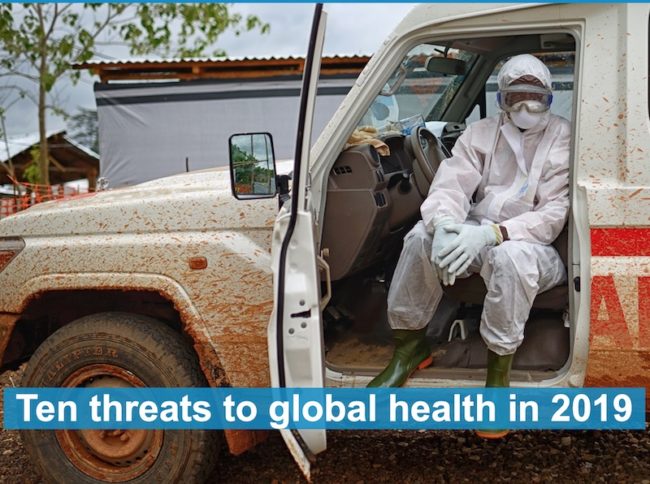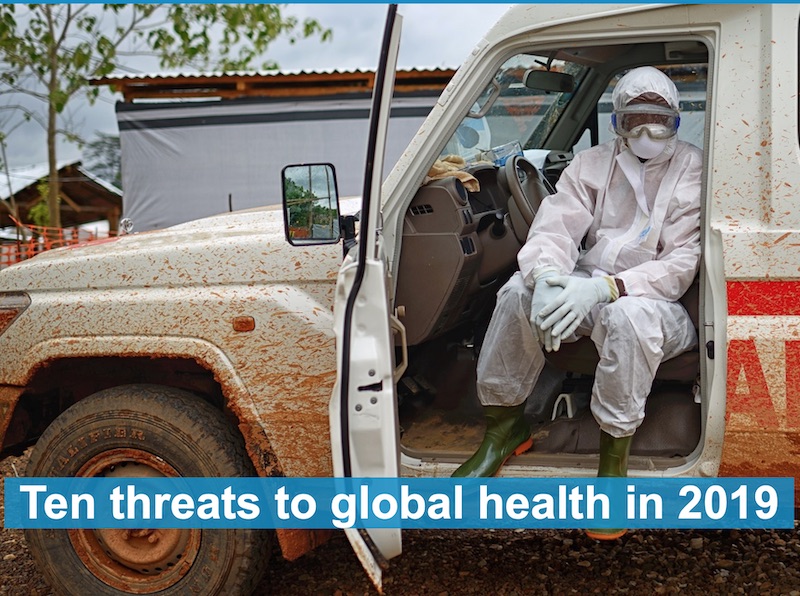
You have no doubt seen that WHO (World Health Organization) have published a list of the top 10 health threats that we face in 2019.
The alpha source is this WHO listing here, let’s take a look.
Ten threats to global health in 2019
Their publication of this list is of course intended to highlight who the World Health Organization are and what they do. These are the issues that the World Health Organization plans to tackle as part of their plan over the next five years.
Understanding a threat means that you can take action to address it, so I’ve not only listed each of the 10 threats, but also specify under each what actions WHO is planning to take because of this awareness …
- Air pollution and climate change – Nine out of ten people breathe polluted air every day. In 2019, air pollution is considered by WHO as the greatest environmental risk to health. …. The primary cause of air pollution (burning fossil fuels) is also a major contributor to climate change, which impacts people’s health in different ways. Between 2030 and 2050, climate change is expected to cause 250 000 additional deaths per year, from malnutrition, malaria, diarrhoea and heat stress
- Response: In October 2018, WHO held its first ever Global Conference on Air Pollution and Health in Geneva. Countries and organizations made more than 70 commitments to improve air quality. This year, the United Nations Climate Summit in September will aim to strengthen climate action and ambition worldwide.
- Noncommunicable diseases – diabetes, cancer and heart disease, are collectively responsible for over 70% of all deaths worldwide, or 41 million people. … Over 85% of these premature deaths are in low- and middle-income countries. The rise of these diseases has been driven by five major risk factors: tobacco use, physical inactivity, the harmful use of alcohol, unhealthy diets and air pollution.
- Response: WHO will work with governments to help them meet the global target of reducing physical inactivity by 15% by 2030
- Global influenza pandemic – The world will face another influenza pandemic – the only thing we don’t know is when it will hit and how severe it will be. The last major one was in 1918 and that killed roughly about 3-5% of the entire human species on the planet.
- Response: WHO is constantly monitoring the circulation of influenza viruses to detect potential pandemic strains: 153 institutions in 114 countries are involved in global surveillance and response. …
- Fragile and vulnerable settings – More than 1.6 billion people (22% of the global population) live in places where protracted crises (through a combination of challenges such as drought, famine, conflict, and population displacement) and weak health services leave them without access to basic care.
- Response: WHO will continue to work in these countries to strengthen health systems so that they are better prepared
- Antimicrobial resistance – Antimicrobial resistance – the ability of bacteria, parasites, viruses and fungi to resist these medicines – threatens to send us back to a time when we were unable to easily treat infections
- Response: WHO is working with these sectors to implement a global action plan to tackle antimicrobial resistance by increasing awareness and knowledge, reducing infection, and encouraging prudent use of antimicrobials.
- Ebola and other high-threat pathogens – In 2018, the Democratic Republic of the Congo saw two separate Ebola outbreaks, both of which spread to cities of more than 1 million people.
- Response: WHO’s R&D Blueprint identifies diseases and pathogens that have potential to cause a public health emergency but lack effective treatments and vaccines.
- Weak primary health care – many countries do not have adequate primary health care facilities.
- Response: WHO will work with partners to revitalize and strengthen primary health care in countries, and follow up on specific commitments made by in the Astana Declaration.
- Vaccine hesitancy – the reluctance or refusal to vaccinate despite the availability of vaccines – threatens to reverse progress made in tackling vaccine-preventable diseases. Vaccination is one of the most cost-effective ways of avoiding disease – it currently prevents 2-3 million deaths a year, and a further 1.5 million could be avoided if global coverage of vaccinations improved.
- Response: In 2019, WHO will ramp up work to eliminate cervical cancerworldwide by increasing coverage of the HPV vaccine, among other interventions. 2019 may also be the year when transmission of wild poliovirus is stopped in Afghanistan and Pakistan.
- Dengue – a mosquito-borne disease that causes flu-like symptoms and can be lethal and kill up to 20% of those with severe dengue, has been a growing threat for decades. … An estimated 40% of the world is at risk of dengue fever, and there are around 390 million infections a year.
- Response: WHO’s Dengue control strategy aims to reduce deaths by 50% by 2020.
- HIV – the epidemic continues to rage with nearly a million people every year dying of HIV/AIDS. Since the beginning of the epidemic, more than 70 million people have acquired the infection, and about 35 million people have died. Today, around 37 million worldwide live with HIV.
- Response: This year, WHO will work with countries to support the introduction of self-testing so that more people living with HIV know their status and can receive treatment (or preventive measures in the case of a negative test result).
Item 8 – Anti-Vaccine
If you happen to believe that vaccines are bad and to be avoided, then you personally are on the list of the top 10 threats that our species faces. Ponder over that one.
Measles, for example, has seen a 30% increase in cases globally. It is not simply an inconvenient childhood illness, it kills. Between roughly 1855 and 2005, measles has been estimated to have killed about 200 million people worldwide.
WHO tactfully suggests … “The reasons why people choose not to vaccinate are complex;” …
a vaccines advisory group to WHO identified complacency, inconvenience in accessing vaccines, and lack of confidence are key reasons underlying hesitancy.
Let me add one more. If you are pushing against vaccines and ignoring the evidence, then you are a gullible idiot who seriously needs to hit pause on that stance and rethink it. – vaccines really do work, and don’t cause autism, the push against them is based upon fraudulent claims.
